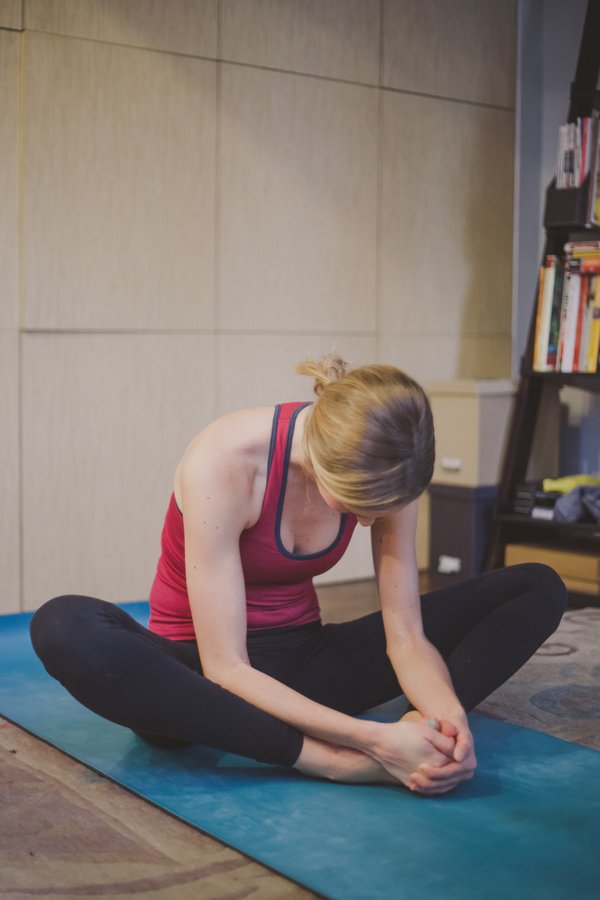
I had many pounds of dread to shed leading up to these challenges. And the biggest one—which, perhaps got me into this weak, shapeless mess in the first place—was my back.
I talked a little bit about this in my intro to exercise month. But what I didn’t mention was one important lesson from my back rehabilitation.
I’ve been up to my elbows in books since I started this project, and it’s a rare day at the office when I don’t learn something new about my body thanks to these amazing experts who have forged the way for my health makeover. I never thought that my favorite among them would come from my back month curriculum. But John Sarno’s Healing Back Pain has far and away been the most eye opening and helpful on this journey.
A mix of self-help and freshman year psych, the book basically explains why highly neurotic, over-achieving people, like yours truly, have so many chronic ailments. Though his expertise is as a chiropractor, Sarno gives the reader an in-depth look at how anxiety and stress can cause pain to bounce around the body, distracting you from the larger issues buried in your subconscious.
If you’ve had issues with back pain, headaches, stomach issues, or any other type of on-going, semi-debilitating bodily woe, I would highly recommend giving the book a read, as understanding this mind-body connection is the first step towards recovery. It definitely doesn’t read like a novel, but you’ll probably find yourself nodding your head a lot during the first chapter.
In addition to reminding your brain that the pain isn’t actually physical, part of Sarno’s recovery program is to return to all intense physical activity you were doing before the back problems started.
“Anyone who has had a serious back attack cannot help but live in terror of the next one,” says Sarno. “Ironically, by contributing to a high level of anxiety this fear almost guarantees that another attack will come sooner or later.” The physical restrictions these fears breed (perpetuated by medical professionals who tell you not to lift, move, or carry yourself a certain way) are often more debilitating than the pain itself, he writes.
I can identify with this. Though my back was a good back pocket excuse for laziness, after I tweaked it several times during yoga, there was definitely a fear in the back of my mind that I was too weak to be exercising at all.
I made baby steps to strengthening my core last month. And I think in doing so, I gained a bit of my confidence back. But if the first part of my exercise challenge was making room for movement again in my life, the second part would have to be leaning into my discomfort and fears around physical activity. And that would involve seeing what all the crazy fitness junkies in New York have been up to all these years.
Read on for how it all went. Warning: it’s a long one!
From one healthy hedonist, to another,
Xo
Phoebe

Physical weakness and back fear was not the only thing that caused my exercise habit to die a slow death. The other factor was self-employment.
When you’re working from home without structure, fulfilling the role of CEO, creative director and accounts payable, interrupting your day to go to yoga can feel like a frivolous waste of time.
My month of 30 minutes of movement a day definitely helped shift my mindset on that front. It made me work walking breaks into my workday in the same way I would have lunch. And those walks ended up being more productive than I had ever given them credit for.
When I was down in Tennessee at the writer’s colony, for lack of any other healthy form of distraction or procrastination, I would end up taking a daily walk around 4pm to clear my head and get my legs moving. I usually returned to my desk a lot more focused than when I left. I worried though that the frenetic energy of the city, plus my tendency to walk with phone in hand, wouldn’t have the same effect once back home.
Studies have shown how mid-day walking can be a meditative experience that reduces work time stress and promotes productivity. But I wondered: how much of that positive impact was the movement and how much was the fresh air?
I did find my daily walking breaks to be similarly rejuvenating in the big city, even if the fresh air was slightly smoggier than when I was in the woods down South. In fact, one of my favorite parts of this 30 minutes of movement experiment was that I did a lot more outdoor activities versus formal exercise. And I think the extra vitamin D was just as worthwhile as the added endorphins from sprinting on a stationary bike for an hour. Plus, it was a lot more efficient for my schedule and left me feeling less guilty than if I had scooted away from my desk for 2 hours to do burpees in a hot crowded room.
Back in May, when I was trying to sit less and move more, I started wearing my Jawbone UP band to see how I was tracking on the step front. It was a helpful tool in the short-term. You don’t really know where you stand until you start monitoring your real time numbers. I learned that I’m more likely to meet my 10K goal on days when I have a lot of meetings around town than I am when doing an hour of exercise and then working from home for the rest of the day.
But in the long-term I’d rather just internalize what a good movement day feels like rather than relying on numbers. And that goes for counting the minutes I’m moving as well.
The “go big, or go home” mantras of most organized fitness classes didn’t jibe well with my wellness ethos. I prefer to respect my limits and be kind to my limbs, thankyouverymuch.
I challenged myself to try at least one new type of exercise class a week. This was made less expensive through ClassPass, which allows you to have a blanket membership for various boutique fitness studios instead of paying the outrageous $30/a pop fee for an individual class.
Unfortunately, I didn’t really succeed in finding a workout buddy whose schedule and fitness level matched my own. My friend Sarah was the best candidate in terms of mid-day availability, but after I accompanied her to an SLT class, which turned out to be pilates on crack, I realized I was way out of my league.
Still, I got dragged to other experiences with various friends. I tried 305 fitness during a bachelorette weekend, which was another humbling physical experience, as the class involved two of the things I suck most at: coordinated dance and cardio.
Hip hop moves were also a small part of my class experience at Bari. But the second half involved a trampoline, so that made up for part of the discomfort with a little childlike fun.
One of the reasons I like yoga so much is that it teaches you to respect your body and work around its limitations. Modifications aren’t seen as a copout—instead, they’re necessary to improve your alignment and posture. The practice emphasizes that the quality of the journey is so much more powerful than the end result.
In general, exercise practices that are motivated by calories burned and pounds shed are no more sustainable than a fad diet.
A few weeks ago, I read an article about how weight loss is not as compelling a reason to get to the gym as simply looking at the experience as nourishment. Dieters and exercise junkies who workout to control their bodies tend to spend less time actually hitting the gym in the long run than people who genuinely find some emotional or internal benefit to getting moving.
I know a lot of my friends sign up for expensive classes because the financial impact is motivating; it ensures they’ll actually haul ass to the studio so they don’t lose their $30, whereas relying on willpower alone might leave them on the couch watching Netflix instead.
I certainly can’t deny this benefit. I wouldn’t have gone to as many classes or experienced “official” exercise as many times a week as I did without having paid a premium in advance for the privilege. But often what happened was that I didn’t always want to be there. I had a hard time embracing the classes as anything other than research.
Because of the advance sign-ups, it often wasn’t what my body craved that day. For instance, I was still so sore from my Bari workout that I couldn’t fully push myself to succeed at The Class. (And, instead, I just giggled awkwardly as people started to sweat and sob around me).
I also think the financial incentive can push you too far. There’s a feeling that you have to get your money’s worth—to complete as many reps and burn as many calories as possible to make the experience worthwhile. This was hard for me to wrap my head around. If you went to a restaurant and the meal didn’t agree with you, would you force yourself to finish your plate? Probably not.
The difference is that most people assume that you can’t have too much exercise. Unlike with food, consuming more movement, can’t be bad for your body.
In general, I wished that more instructors promoted the idea of creating your own experience, rather than pushing yourself to a point of being uncomfortable or destructive. In The Class, which was the most touchy feely of these high intensity workouts, there was a lot of emphasis on looking within yourself, but not a whole lot about listening to your body.
The one bright spot, and probably the only class I would return to was Barre3. I’m slightly biased, as the owner, Portland-based Sadie Lincoln, was the first person I met at Mind Body Green’s Revitalize event a few months ago. I really dug her philosophy, which she told me about on the shuttle bus from the airport to the retreat. But I wasn’t sure I would necessarily love her workout.
“Remember to always be kind to your body” Sadie said over the mic as we alternated between squats and bar planks. “One of the things I hate about the exercise industry is how they make it seem like pain is necessary. No pain, no gain is the standard philosophy. And it’s so not true. If your body doesn’t feel good, you should modify.”
I’m pretty comfortable with my own shortcomings in the exercise department. But even in yoga I sometimes feel my ego getting the best of me. It sucks to be the only person who can’t keep up. And that can easily become a mob mentality that forces everyone into a dangerous fitness territory.
“It’s important to push yourself a little bit and feed off the energy in the room. But you always have to check in with yourself,” said Sadie.
At SLT, I had no choice but to drop out at certain points. But the rest of the time, I was pushing myself too hard. I probably shouldn’t have been there in the first place. The format didn’t serve me at all. And it definitely wasn’t kind or fun.
There’s a healthy kind of soreness in the days that follow a workout. And then there’s the kind that makes sitting on a toilet make you want to cry.
After Sadie’s class I felt really relaxed and balanced. Her approach lacked so much of the machismo that dominated even most of the classes taught by women to women. I ended up leaving stronger, looser, and less sore than I was when I came, thanks to a healthy amount of time dedicated to winding down and stretching at the end (another thing most other classes lacked).
I could go on and on about some of my experiences in these classes, and I do have the desire to keep trying more through my ClassPass membership. But I think I’ve discovered so far that these trendy workouts just aren’t for me. I thought I would find a shoe that fit. But I think I’m just a simpleton who likes yoga and pilates, walking and biking.
Despite my hating, now that I’ve had a week to cool down, I must say that my body feels pretty great! And I definitely successfully jumped many mental hurdles. If I can survive mega reformers, trampolines, dance routines and lady viking battle cries, then I’m pretty sure my mind and body are ready for anything.
Do you have any favorite classes? Does group exercise motivate you or make you want to jump off a Bari trampoline and out the window? I’m curious to hear your thoughts on my heavyweight fitness takedown in the comments section!
[Also, sorry for the lack of photos on instagram or otherwise. As it turns out, it’s hard to take a selfie when you can barely lift your arms.]
The Wellness Project is now a book! It’s part memoir, part health primer, with 20 inflammation fighting recipes for clearer skin, better digestion, and a thriving thyroid. (Because who doesn’t wake up in the morning wanting a thriving thyroid?!). You can read more and preorder here. To read up on past experiments and get more tips from the trenches, click here.

Ages ago I took a popular step class when I was In LA, where the instructor had the class do the moves really slowly to a slow beat. I was surprised that this measured, controlled approach was actually harder than the frenetic speed I was used to in NY. I’ve read that some experts say doing strength and cardio workouts very slowly instead of New York-Style frantica is more effective than flinging yourself around like you’re on meth.
Going slower is definitely harder and more effective! that’s why I like pilates because the movements are so small, but when you do them correctly, they are incredibly hard.
I think the reason why people don’t stick with exercise is because they’re only doing it to achieve a “bikini bod.” I know for me, when I started focusing on how exercise relived my stressed and helped me sleep better at night, I began to enjoy it more. Now if I don’t do some kind of exercise for a couple days, I begin to really miss it and feel my body/mind get out of whack. I like group classes but I don’t like paying the high price tag for them lol. I’m really big into exercising outside, doing fitness DVDs/YouTube videos or blasting some music and dancing. At the end of the day, if you find something you enjoy and it’s good for your body/mind, that’s all that really matters.
TOTALLY. Amen sister. So important to find what works for both mind/body. People focus too much on the latter and hate exercise as a result. I finally got over the fact that I hate trendy fitness classes. There’s nothing wrong with it! Luckily yoga works well for me on the mind body front. Thank you for reading and sharing!
I love zumba! Dancing is one of the few things I am good at and the cardio level is nice and challenging. I just really love shaking my bootie (literally – I love to shimmy) so for that to become exercise is pretty rad. I also really like strength training and weight lifting. I am not a light weight -not fat, but rather busty with a bootie and I could never be tall or willowy. So I have found that the healthiest approach for me (physically, mentally and emotionally) is just to do things I enjoy and then I really like myself and the exercise I lot more. I am VERY fortunate to have an amazing gym buddy – we often go at lunch. I agree that getting out during the middle of the day makes for a much better afternoon. I’m a librarian so I sit on my butt in front of the computer for most of the day, like many.
I am always on this elusive quest to look “better” to lose weight but I’ve really, really tried to just enjoy the fact that I am toned and strong…with maybe a bit of cushy covering that makes for good hugs 😛
that’s totally it Sarah, and I’m so glad you enjoy shaking your bootie!! I wish I was better at it so I could feel better about doing so outside a very dark dance environment with lots of booze involved. Embrace that divine femininity gurl – I think the sexiest women have cushy tushies. thank you for sharing your story!! I know that sitting is a drag, but maybe putting back big books on high shelves is hidden weight training?? xoxo